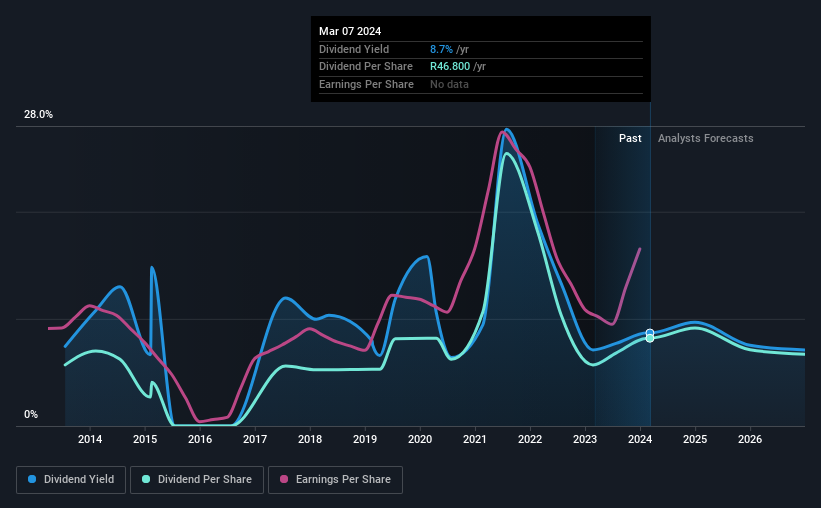
Some investors rely on dividends for growing their wealth, and if you're one of those dividend sleuths, you might be intrigued to know that Kumba Iron Ore Limited (JSE:KIO) is about to go ex-dividend in just four days. The ex-dividend date is usually set to be one business day before the record date which is the cut-off date on which you must be present on the company's books as a shareholder in order to receive the dividend. The ex-dividend date is of consequence because whenever a stock is bought or sold, the trade takes at least two business day to settle. Meaning, you will need to purchase Kumba Iron Ore's shares before the 13th of March to receive the dividend, which will be paid on the 18th of March.
The company's upcoming dividend is R024.20 a share, following on from the last 12 months, when the company distributed a total of R46.80 per share to shareholders. Calculating the last year's worth of payments shows that Kumba Iron Ore has a trailing yield of 8.7% on the current share price of R0539.19. If you buy this business for its dividend, you should have an idea of whether Kumba Iron Ore's dividend is reliable and sustainable. As a result, readers should always check whether Kumba Iron Ore has been able to grow its dividends, or if the dividend might be cut.
Check out our latest analysis for Kumba Iron Ore
Dividends are typically paid from company earnings. If a company pays more in dividends than it earned in profit, then the dividend could be unsustainable. Kumba Iron Ore paid out 66% of its earnings to investors last year, a normal payout level for most businesses. That said, even highly profitable companies sometimes might not generate enough cash to pay the dividend, which is why we should always check if the dividend is covered by cash flow. Over the last year it paid out 60% of its free cash flow as dividends, within the usual range for most companies.
It's positive to see that Kumba Iron Ore's dividend is covered by both profits and cash flow, since this is generally a sign that the dividend is sustainable, and a lower payout ratio usually suggests a greater margin of safety before the dividend gets cut.
Click here to see the company's payout ratio, plus analyst estimates of its future dividends.

Have Earnings And Dividends Been Growing?
Businesses with strong growth prospects usually make the best dividend payers, because it's easier to grow dividends when earnings per share are improving. If earnings decline and the company is forced to cut its dividend, investors could watch the value of their investment go up in smoke. Fortunately for readers, Kumba Iron Ore's earnings per share have been growing at 19% a year for the past five years. Kumba Iron Ore is paying out a bit over half its earnings, which suggests the company is striking a balance between reinvesting in growth, and paying dividends. Given the quick rate of earnings per share growth and current level of payout, there may be a chance of further dividend increases in the future.
Another key way to measure a company's dividend prospects is by measuring its historical rate of dividend growth. In the past 10 years, Kumba Iron Ore has increased its dividend at approximately 3.7% a year on average. It's good to see both earnings and the dividend have improved - although the former has been rising much quicker than the latter, possibly due to the company reinvesting more of its profits in growth.
To Sum It Up
Is Kumba Iron Ore worth buying for its dividend? Higher earnings per share generally lead to higher dividends from dividend-paying stocks over the long run. However, we'd also note that Kumba Iron Ore is paying out more than half of its earnings and cash flow as profits, which could limit the dividend growth if earnings growth slows. To summarise, Kumba Iron Ore looks okay on this analysis, although it doesn't appear a stand-out opportunity.
With that in mind, a critical part of thorough stock research is being aware of any risks that stock currently faces. To help with this, we've discovered 2 warning signs for Kumba Iron Ore (1 is a bit unpleasant!) that you ought to be aware of before buying the shares.
A common investing mistake is buying the first interesting stock you see. Here you can find a full list of high-yield dividend stocks.
Valuation is complex, but we're here to simplify it.
Discover if Kumba Iron Ore might be undervalued or overvalued with our detailed analysis, featuring fair value estimates, potential risks, dividends, insider trades, and its financial condition.
Access Free AnalysisHave feedback on this article? Concerned about the content? Get in touch with us directly. Alternatively, email editorial-team (at) simplywallst.com.
This article by Simply Wall St is general in nature. We provide commentary based on historical data and analyst forecasts only using an unbiased methodology and our articles are not intended to be financial advice. It does not constitute a recommendation to buy or sell any stock, and does not take account of your objectives, or your financial situation. We aim to bring you long-term focused analysis driven by fundamental data. Note that our analysis may not factor in the latest price-sensitive company announcements or qualitative material. Simply Wall St has no position in any stocks mentioned.
About JSE:KIO
Kumba Iron Ore
Engages in the exploration, extraction, beneficiation, marketing, sale, and shipping of iron ore for the steel industry primarily in South Africa, China, rest of Asia, Europe, the Middle East, and North Africa.
Outstanding track record with excellent balance sheet and pays a dividend.


